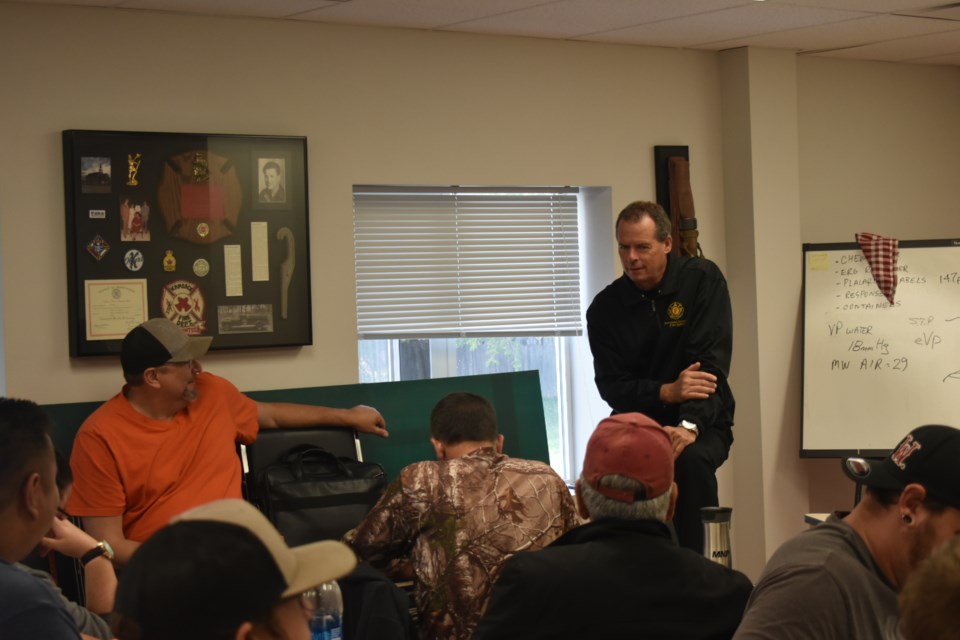KAMSACK — Firefighters from across the area engaged in a training exercise focusing on hazardous materials and response procedures from Sept. 8 to 10. The training was part of a federal government program that has been ongoing for several years, with multiple sessions taking place across Western Canada. This hazard response program aims to educate firefighters and first responders on how to handle hazardous materials incidents. The program was taught by, Reid Wharton from B. C. and Brent Cowx.
Wharton said, “So this is part of the federal government program. Seven of us are in Canada, training going around Canada, I sort of look out for Western Canada. We go around in the fire departments for hazardous material response training. All this is sponsored by the federal government through your Ministry of Public Safety.
“The program started in 2015 and the grant just got renewed again in March for another three years.”
During the training, responders were faced with hypothetical scenarios involving various hazardous materials and practiced their response strategies. They utilized the Emergency Response Guidebook (ERG) to gather critical information about the nature of the materials, potential hazards, and recommended actions. The ERG is a valuable resource that provides essential information for first responders to assess and manage hazardous incidents.
In one scenario, responders were faced with a leaking propane tank in a trailer park during the early hours of the morning. The exercise emphasized the importance of understanding the properties of hazardous materials, such as propane. Propane is highly flammable and has specific characteristics, such as being heavier than air and having an explosive range. Responders learned that propane vapour can be pushed away using positive-pressure fans and that water can be used to create a vapour-suppressing mist to mitigate potential dangers.
The training also emphasized the need for a systematic approach to incident management. Responders first assessed the situation, identified potential hazards, and determined the appropriate response based on the ERG guidelines. They considered factors such as the location of the leak, the concentration of the hazardous material, and the safety of nearby residents. The goal was to minimize the risk to both responders and the public.
As the scenario evolved, responders discussed strategies for evacuation and containment, recognizing that safety is paramount in any hazardous materials incident. They also highlighted the importance of communication and co-ordination among responding agencies.
Another scenario talked about what to do during an accident where a truck with a radioactive materials placard was overturned and lying on its side with its driver incapacitated. Some of the firefighters who attended the event were very quick to decide in to avoid all contact with the vehicle in this hypothetical situation. Their instructor at that time, Reid Wharton, later reminded the firefighters that most if not all radioactive incidents are fairly safe, self-contained, and pose little risk to them.
Wharton said, “Hey, everybody gets freaked out about rad stuff. But in reality, they’re so well controlled and so well packaged. It’s not a huge concern for us. They had a building that created medical isotopes for X-rays, and medical imaging by Chalk River, it was getting old and shut down a number of years ago. There's no other facility in North America that has a nuclear plant and nuclear raw material and the facility to make those medical isotopes side by side. So as a result, they're shipping more and more nuclear material up to different universities and that is to make medical isotopes. So there's more and more rad stuff on the road. But again, the reality is it’s so well controlled, so well packaged. That is not a huge concern for us.”
Wharton also mentioned a story about a firefighting team from San Diego stumbling onto a 53-foot road trailer with a radioactive placard, something that Sam, a firefighter used to hazmat training, had never seen before.
“Some firefighters from San Diego had to go to the grocery store to get some groceries. So they go to the mall. One of them, Sam, stayed in the truck, and the guys went into the grocery store. Sam's looking around the parking lot. There's a 53-foot road trailer parked over in the front corner with a radioactive placard on the side of it. He thought to himself, ‘I've never seen a 53-foot road trailer with a radioactive placard,” and he's kind of pondering it, right? A guy comes out of the mall and goes over to it, he's obviously the driver there. So Sam got out of the fire truck and was over here. Sam said, ‘So obviously, I'm a hazmat guy and I’ve never seen a 53-foot road trailer with radioactive placards on it. I'm just wondering what you packing.’ The guy says, ‘Actually I got big screen TVs and I just didn't want anybody to steal my rig. So I put a radioactive placard on my truck.’
“I’ve had a commercial vehicle inspector on another course I did,” continued Wharton. “When I mentioned that story he said that would be an automatic $595 fine.”
This training session provided valuable hands-on experience for first responders, helping them become better equipped to handle hazardous materials incidents effectively and safely. It underscored the significance of understanding the chemical and physical properties of hazardous materials, using available resources like the ERG, and following a structured approach to incident management.
Live in Canora, Kamsack or Preeceville? We're going to be launching a new newsletter called the Assiniboine Valley Source. Sign up today!




